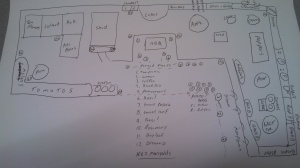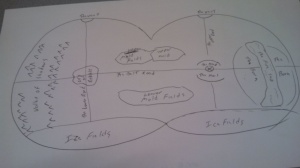Who doesn’t love maps? I am a self-professed cartophile. As a teen I had AAA state maps alongside my posters of Frodo, Pam Grier, and Isaac Asimov. I still have one of those old-world maps in a frame I got as a gift seven years ago. I really have to hang it up one of these days.
For anyone who has read an epic novel, your first experience is the map at the front of the book. The little graphic depiction of the world you are about to immerse yourself in sets the stage for all the lands you will travel through. The same can be said for gardens. Mapping your beds is key for a productive garden.
This is the time of year that my wife and I pull out a large sketchpad and make out where the seedlings are going.  We check it against the last few years’ maps to make sure we don’t put the same plant in a bed that had it there recently. Tomatoes are particularly sensitive to blossom end rot from being planted in the same soil year after year. You also don’t want incompatible plants growing next to each other like melons and potatoes. A wise gardener will put a nitrogen hungry plant (corn) where nitrogen fixers (beans) grew the year before.
We check it against the last few years’ maps to make sure we don’t put the same plant in a bed that had it there recently. Tomatoes are particularly sensitive to blossom end rot from being planted in the same soil year after year. You also don’t want incompatible plants growing next to each other like melons and potatoes. A wise gardener will put a nitrogen hungry plant (corn) where nitrogen fixers (beans) grew the year before.
I’m a pro when it comes to mapping out a garden but I suck at mapping out my worlds. I draw out a rough sketch and that does it for me.  The big temptation is to download or (bleh) purchase a map making software. Don’t do it, unless you want to waste an incredible amount of time learning the software only to end up with a crappy map. Leave it up to the publisher to finish a map.
The big temptation is to download or (bleh) purchase a map making software. Don’t do it, unless you want to waste an incredible amount of time learning the software only to end up with a crappy map. Leave it up to the publisher to finish a map.
Garden and author maps are not meant for the general public. They are messy, often inaccurate things that can confuse those not living in our worlds. With a map you can (generally) see where you are heading. Without one, it is very easy to get lost and even easier to give up.
